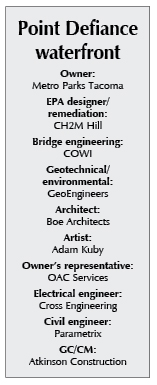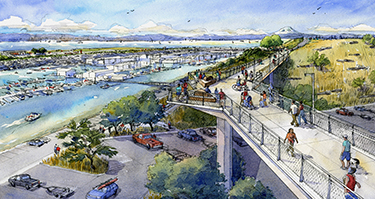|
Subscribe / Renew |
|
|
Contact Us |
|
| ► Subscribe to our Free Weekly Newsletter | |
| home | Welcome, sign in or click here to subscribe. | login |
Construction
| |
 |
December 9, 2016
11-acre waterfront park will top huge slag pile
Site Workshop Landscape Architecture

Beaudoin
|
The swarm of trucks currently moving 350,000 cubic yards of earth makes it obvious that something major is underway at Tacoma’s historic Point Defiance waterfront.
The dramatic earthmoving effort is just the beginning of a phased transformation of a contaminated Superfund site into a multi-layered recreational space that expands one of the region’s most beloved parks.
“Metro Parks Tacoma has been working for decades on how to best connect Point Defiance Park with the Tacoma waterfront,” said Roger Stanton, project manager with Metro Parks.
“Knowing that the land is polluted from a local smelter, spans multiple jurisdictions, and is highly valued by the community, we knew the design challenge would be as complex as the circumstances surrounding it.”
As landscape architects leading a multidisciplinary team, we felt a great responsibility to ensure this expansion of Point Defiance Park respects its natural and industrial history, as well as the interests of the more than 3 million users who visit the park each year. Created in 1888, the 760-acre park is home to remnant old growth forest, along with cultural institutions such as the Point Defiance Zoo and Aquarium, Fort Nisqually Living History Museum, Japanese Garden, and the Science & Math Institute.
Remediating contaminated soil is just the start of a larger effort to embrace the waterfront as an integral part of the greater park.
Decades of contamination
A 571-foot-tall brick smokestack once towered over Tacoma’s shoreline between Point Defiance Park and the town of Ruston as an iconic, regional landmark. Built in 1917, the smokestack served what eventually became one of the largest employers in Pierce County, the Asarco copper smelter.
For decades, the smokestack spewed lead, arsenic and other contaminants over the park, surrounding neighborhoods and throughout the South Sound. By the time the plant closed in 1985, the Environmental Protection Agency listed the 67-acre property as one of the nation’s most polluted Superfund sites.
The smelter stack was torn down in 1993, leaving an enduring legacy of contaminated soil that has been the focus of ongoing remediation. While the lingering contamination remains largely invisible, sitting just off the Point Defiance shoreline is a prominent reminder of the site’s history: a 23-acre peninsula of slag that formed as the Asarco plant routinely dumped solid-waste arsenic and lead into Puget Sound.
Transforming the waterfront
Today the massive slag pile is the heart of a major redevelopment of the Point Defiance waterfront. In partnership with the EPA, Metro Parks Tacoma is redeveloping the peninsula as a new recreational amenity for the greater park.
The peninsula’s embankment is currently being stabilized and “armored” with large stones to protect the slag from being broken down by ocean currents and released into Puget Sound. Contaminated soil from the park’s upland areas is also being excavated, relocated to the peninsula, and capped with clean earth harvested from lower depths.
Moving so much soil around the site provides opportunities to meet other long-term goals for Point Defiance. This includes stabilizing the bluff above the marina, providing ADA connections from the waterfront to the park, improving boat access and parking, redesigning the Pearl Street entrance, and creating a range of new park amenities.
New park space
The final design for the peninsula emerged from a concept plan that our office developed for the site in 2004, collaborating with the local community, Metro Parks Tacoma and other stakeholders.

A primary feature of the park is the sculpted landforms that embrace the panoramic, 270-degree views of Mount Rainier, Vashon Island and Puget Sound. Three sail-like mounds are built up with contaminated fill and a clean soil cap that reaches towering heights to shape the visitor experience and frame views.
Emphasizing passive recreation, the site design integrates a variety of gathering areas, art installations and paths for strolling or jogging. The north end of the peninsula serves as a flexible, outdoor events venue. Artful elements are woven throughout the site, expressing the site’s ecological and cultural legacy in engaging ways.
The redevelopment also accommodates the Tacoma Yacht Club, which has leased part of the slag peninsula for its clubhouse since 1971.
Connecting the peninsula to the shoreline, the project adds a key segment of the Dome to Defiance Trail, a planned 8.5-mile, multimodal trail that leads from downtown Tacoma to Point Defiance Park. Before continuing along the waterfront, the trail will fork off from Ruston Way to provide the only ADA-accessible link between the shoreline and the upland park.
The trail design also incorporates a variety of placemaking elements, including a new park entry, overlook areas, and unstructured, nature-based play opportunities. One fun surprise along the trail is 60 feet of slides running parallel to a hillside stairway.
Prairie plantings
Planting on the peninsula evokes a rapidly disappearing part of our region’s natural history with expansive native prairie. Once common throughout Puget Sound, only 3 percent of our native prairies remain. The prairie planting will provide valuable urban habitat, as well as educational opportunities to support awareness and conservation.
Given the scale of the new park space, the prairie concept brought additional benefits to the project. Since the chosen plant palette thrives on well-drained, low-nutrient soils, we were able to use excavated subsoils from the bluff as planting soil with minimal imported amendments. And not least, the prairie will require significantly lower maintenance resources over the long term, compared with traditional lawn and shrub planting.
Scheduled for completion in late 2017, the project has been complex in both scope and scale. In addition to managing a diverse consultant team, multiple funding sources with various requirements, and a general contractor/construction manager delivery method, our work involved extensive coordination with two cities, the Washington State Department of Transportation, Washington State Ferries, Environmental Protection Agency, the Department of Ecology, Point Ruston LLC and the Tacoma Yacht Club.
While similar projects are often led by engineers or architects, we’re convinced that our perspective as landscape architects was essential in developing integrated design solutions that enhanced the overall project.
Roger Stanton, the Metro Parks Tacoma project manager, would agree.
“As an architect, I wasn’t sure how it would be to have a landscape architect as the prime designer on our $60 million project,” he said. “What I have learned is that (landscape architects), Site Workshop in particular, have a great perspective on large site projects that extends beyond what architects and engineers typically focus on.”
Clayton Beaudoin is a principal at Site Workshop Landscape Architecture.
Other Stories:
- The Foss is a hot spot for development in Tacoma
- Nonprofit brings art to Point Ruston
- An urban park entices Tacomans back in the water
- Point Ruston goes from cleanup to community



